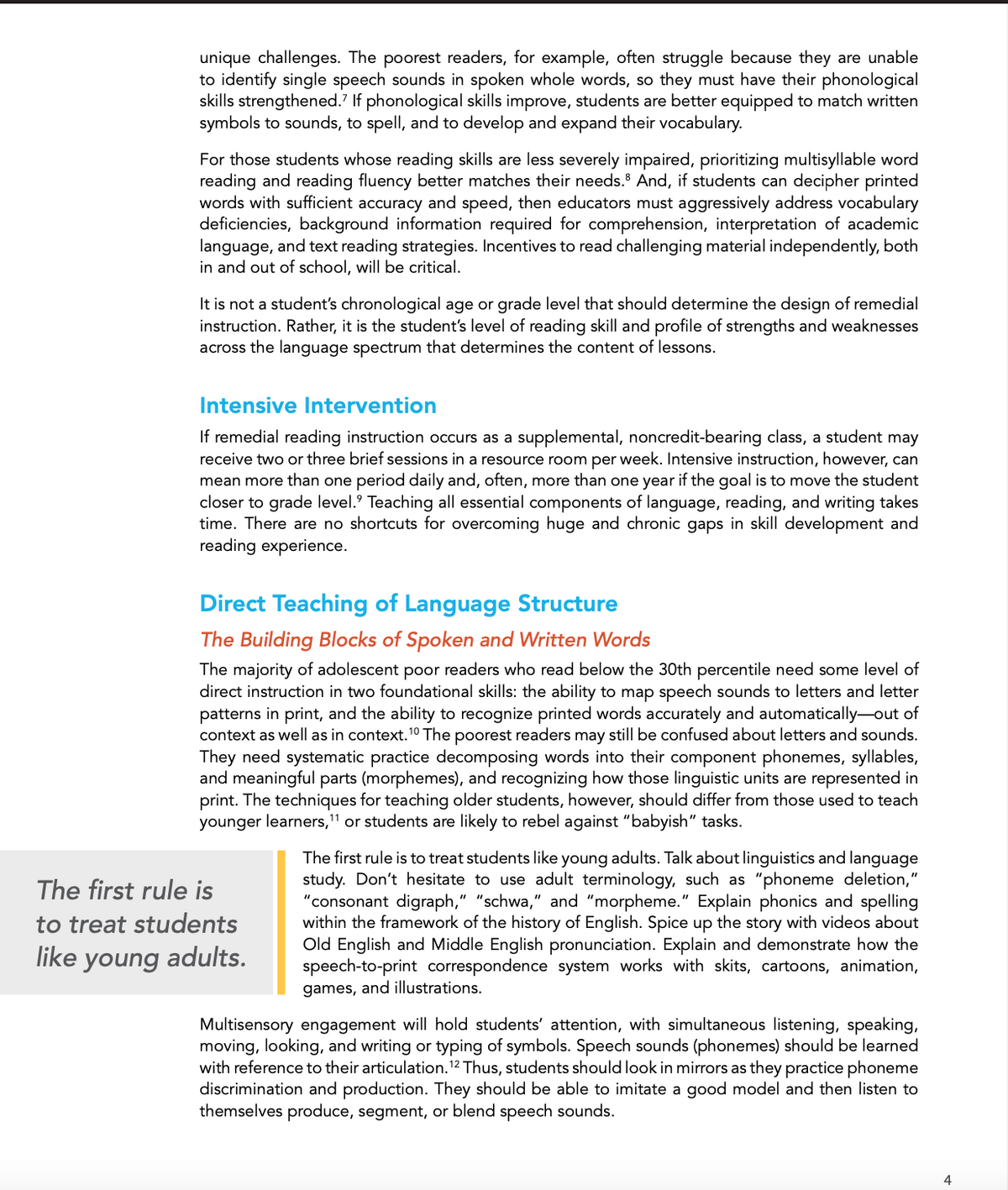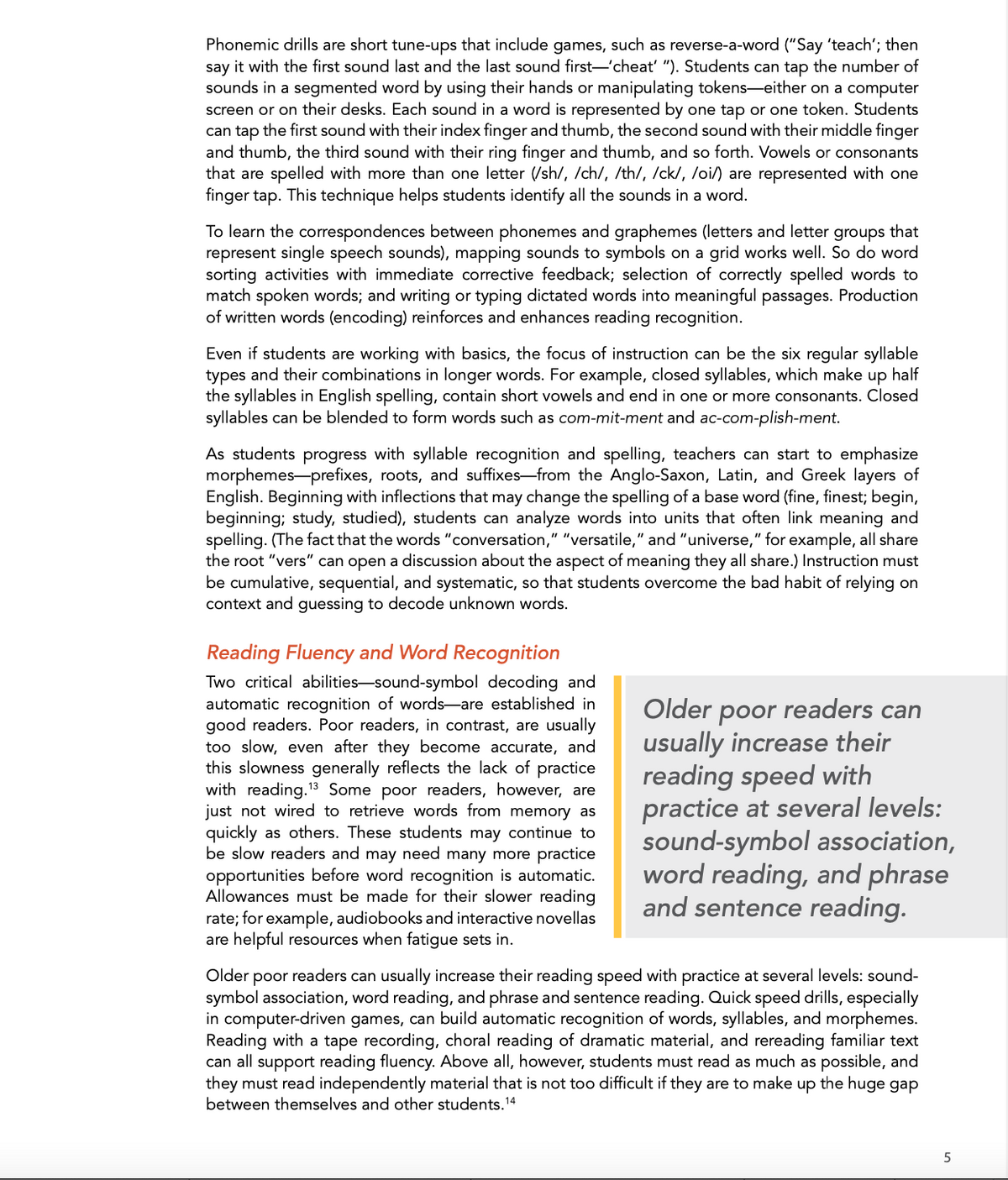What are two reasons why middle and high school students may struggle with reading and literacy?
What are two reasons why middle and high school students may struggle with reading and literacy?
Social Psychology (10th Edition)
10th Edition
ISBN:9780134641287
Author:Elliot Aronson, Timothy D. Wilson, Robin M. Akert, Samuel R. Sommers
Publisher:Elliot Aronson, Timothy D. Wilson, Robin M. Akert, Samuel R. Sommers
Chapter1: Introducing Social Psychology
Section: Chapter Questions
Problem 1RQ1
Related questions
Question
Question: What are two reasons why middle and high school students may struggle with reading and literacy?

Transcribed Image Text:unique challenges. The poorest readers, for example, often struggle because they are unable
to identify single speech sounds in spoken whole words, so they must have their phonological
skills strengthened. If phonological skills improve, students are better equipped to match written
symbols to sounds, to spell, and to develop and expand their vocabulary.
For those students whose reading skills are less severely impaired, prioritizing multisyllable word
reading and reading fluency better matches their needs. And, if students can decipher printed
words with sufficient accuracy and speed, then educators must aggressively address vocabulary
deficiencies, background information required for comprehension, interpretation of academic
language, and text reading strategies. Incentives to read challenging material independently, both
in and out of school, will be critical.
It is not a student's chronological age or grade level that should determine the design of remedial
instruction. Rather, it is the student's level of reading skill and profile of strengths and weaknesses
across the language spectrum that determines the content of lessons.
Intensive Intervention
If remedial reading instruction occurs as a supplemental, noncredit-bearing class, a student may
receive two or three brief sessions in a resource room per week. Intensive instruction, however, can
mean more than one period daily and, often, more than one year if the goal is to move the student
closer to grade level. Teaching all essential components of language, reading, and writing takes
time. There are no shortcuts for overcoming huge and chronic gaps in skill development and
reading experience.
Direct Teaching of Language Structure
The Building Blocks of Spoken and Written Words
10-
The majority of adolescent poor readers who read below the 30th percentile need some level of
direct instruction in two foundational skills: the ability to map speech sounds to letters and letter
patterns in print, and the ability to recognize printed words accurately and automatically-out of
context as well as in context. ¹0 The poorest readers may still be confused about letters and sounds.
They need systematic practice decomposing words into their component phonemes, syllables,
and meaningful parts (morphemes), and recognizing how those linguistic units are represented in
print. The techniques for teaching older students, however, should differ from those used to teach
younger learners,¹1 or students are likely to rebel against "babyish" tasks.
The first rule is
to treat students
like young adults.
The first rule is to treat students like young adults. Talk about linguistics and language
study. Don't hesitate to use adult terminology, such as "phoneme deletion,"
"consonant digraph," "schwa," and "morpheme." Explain phonics and spelling
within the framework of the history of English. Spice up the story with videos about
Old English and Middle English pronunciation. Explain and demonstrate how the
speech-to-print correspondence system works with skits, cartoons, animation,
games, and illustrations.
Multisensory engagement will hold students' attention, with simultaneous listening, speaking,
moving, looking, and writing or typing of symbols. Speech sounds (phonemes) should be learned
with reference to their articulation. ¹2 Thus, students should look in mirrors as they practice phoneme
discrimination and production. They should be able to imitate a good model and then listen to
themselves produce, segment, or blend speech sounds.
4

Transcribed Image Text:Phonemic drills are short tune-ups that include games, such as reverse-a-word ("Say 'teach'; then
say it with the first sound last and the last sound first-'cheat' "). Students can tap the number of
sounds in a segmented word by using their hands or manipulating tokens-either on a computer
screen or on their desks. Each sound in a word is represented by one tap or one token. Students
can tap the first sound with their index finger and thumb, the second sound with their middle finger
and thumb, the third sound with their ring finger and thumb, and so forth. Vowels or consonants
that are spelled with more than one letter (/sh/, /ch/, /th/, /ck/, /oi/) are represented with one
finger tap. This technique helps students identify all the sounds in a word.
To learn the correspondences between phonemes and graphemes (letters and letter groups that
represent single speech sounds), mapping sounds to symbols on a grid works well. So do word
sorting activities with immediate corrective feedback; selection of correctly spelled words to
match spoken words; and writing or typing dictated words into meaningful passages. Production
of written words (encoding) reinforces and enhances reading recognition.
Even if students are working with basics, the focus of instruction can be the six regular syllable
types and their combinations in longer words. For example, closed syllables, which make up half
the syllables in English spelling, contain short vowels and end in one or more consonants. Closed
syllables can be blended to form words such as com-mit-ment and ac-com-plish-ment.
As students progress with syllable recognition and spelling, teachers can start to emphasize
morphemes-prefixes, roots, and suffixes-from the Anglo-Saxon, Latin, and Greek layers of
English. Beginning with inflections that may change the spelling of a base word (fine, finest; begin,
beginning; study, studied), students can analyze words into units that often link meaning and
spelling. (The fact that the words "conversation," "versatile," and "universe," for example, all share
the root "vers" can open a discussion about the aspect of meaning they all share.) Instruction must
be cumulative, sequential, and systematic, so that students overcome the bad habit of relying on
context and guessing to decode unknown words.
Reading Fluency and Word Recognition
Two critical abilities-sound-symbol decoding and
automatic recognition of words-are established in
good readers. Poor readers, in contrast, are usually
too slow, even after they become accurate, and
this slowness generally reflects the lack of practice
with reading. 13 Some poor readers, however, are
just not wired to retrieve words from memory as
quickly as others. These students may continue to
be slow readers and may need many more practice
opportunities before word recognition is automatic.
Allowances must be made for their slower reading
rate; for example, audiobooks and interactive novellas
are helpful resources when fatigue sets in.
Older poor readers can
usually increase their
reading speed with
practice at several levels:
sound-symbol association,
word reading, and phrase
and sentence reading.
Older poor readers can usually increase their reading speed with practice at several levels: sound-
symbol association, word reading, and phrase and sentence reading. Quick speed drills, especially
in computer-driven games, can build automatic recognition of words, syllables, and morphemes.
Reading with a tape recording, choral reading of dramatic material, and rereading familiar text
can all support reading fluency. Above all, however, students must read as much as possible, and
they must read independently material that is not too difficult if they are to make up the huge gap
between themselves and other students. 14
5
Expert Solution
This question has been solved!
Explore an expertly crafted, step-by-step solution for a thorough understanding of key concepts.
This is a popular solution!
Trending now
This is a popular solution!
Step by step
Solved in 2 steps

Recommended textbooks for you

Social Psychology (10th Edition)
Sociology
ISBN:
9780134641287
Author:
Elliot Aronson, Timothy D. Wilson, Robin M. Akert, Samuel R. Sommers
Publisher:
Pearson College Div

Introduction to Sociology (Eleventh Edition)
Sociology
ISBN:
9780393639407
Author:
Deborah Carr, Anthony Giddens, Mitchell Duneier, Richard P. Appelbaum
Publisher:
W. W. Norton & Company

The Basics of Social Research (MindTap Course Lis…
Sociology
ISBN:
9781305503076
Author:
Earl R. Babbie
Publisher:
Cengage Learning

Social Psychology (10th Edition)
Sociology
ISBN:
9780134641287
Author:
Elliot Aronson, Timothy D. Wilson, Robin M. Akert, Samuel R. Sommers
Publisher:
Pearson College Div

Introduction to Sociology (Eleventh Edition)
Sociology
ISBN:
9780393639407
Author:
Deborah Carr, Anthony Giddens, Mitchell Duneier, Richard P. Appelbaum
Publisher:
W. W. Norton & Company

The Basics of Social Research (MindTap Course Lis…
Sociology
ISBN:
9781305503076
Author:
Earl R. Babbie
Publisher:
Cengage Learning

Criminalistics: An Introduction to Forensic Scien…
Sociology
ISBN:
9780134477596
Author:
Saferstein, Richard
Publisher:
PEARSON

Sociology: A Down-to-Earth Approach (13th Edition)
Sociology
ISBN:
9780134205571
Author:
James M. Henslin
Publisher:
PEARSON

Society: The Basics (14th Edition)
Sociology
ISBN:
9780134206325
Author:
John J. Macionis
Publisher:
PEARSON